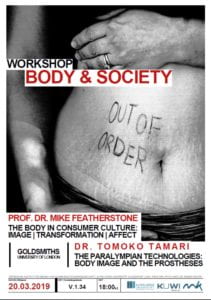 Mike Featherstone and Tomoko Tamari were invited for the workshop, Body & Society by Institute for Media and Communication, Alpen-Adria Klagenfurt University on Wednesday 20 March 2019. The audience consisted of faculty members, from Philosophy, Psychology, Sociology, Art, Gender Studies, and Media and Communication Studies. Following the two lectures, a lively discussion ensured possible future research relationships were discussed.
Mike Featherstone and Tomoko Tamari were invited for the workshop, Body & Society by Institute for Media and Communication, Alpen-Adria Klagenfurt University on Wednesday 20 March 2019. The audience consisted of faculty members, from Philosophy, Psychology, Sociology, Art, Gender Studies, and Media and Communication Studies. Following the two lectures, a lively discussion ensured possible future research relationships were discussed.
The Body in Consumer Culture: Image, Transformation and Affect
Mike Featherstone, Goldsmiths, University of London
The body is accorded a central status within consumer culture. There is a constant proliferation of images of youth, fitness and beauty combined with a more general ‘if you look good you feel good’ philosophy. The benefits of active body maintenance, slimming and fitness regimes are presented as keys to an overall life transformation. Yet despite the flow of body images, a question mark can be put against the belief that constant attention to appearance and ‘looking good’ actually delivers the anticipated promise. The rationalistic assumptions found in some of the media life transformation publicity television programmes such as ‘Extreme Makeover’ and ‘Look Ten Years Younger,’ can be seen as problematic. There is the assumption that people are constantly preoccupied with their body image and the benefits of reconstructive work. Rather, than dwell on the notion that attention to improving our body image will make us happy, the focus should also be on ‘the body without image,’ the body in motion, the affective body which operates in everyday life. This paper utilizes perspectives developed within the sociology of the body and body studies to investigate the tension between body image and the ‘body without image.’
The Paralympian Technologies: Body Image and the Prostheses
Tomoko Tamari, Goldsmiths, University of London
The success of the London 2012 Paralympics opened up not only new public possibilities for the disabled, but also thrusted the debates about the relationship between elite Paralympians and advanced prosthetic technologies into the spotlight. Focusing on the former Paralympian, Oscar Pistorius as a case study, the paper argues that prostheses could be seen to work in two paradoxical ways: they can be an obvious sign of impairment (the visibility of disability), but at the same time, they can conceal the image of the disability (the invisibility of disability).
The paper also explores how the contemporary discourse of prosthesis has shifted from the made-up and camouflaged body to the empowered and exhibited body, to the extent that it is opening up a new social and cultural sensitivity about body image – prosthetic aesthetics. The paper also endeavours to articulate the ambivalent emotions and feelings about prosthetic bodies. Prosthetic aesthetics generates two contradictory sensitivities: attractiveness/’coolness’ which can derive from the image of a perfect human-machine synthetic body, and abjection/uncanny which can be evoked by the actual materiality of the lived body incorporating lifeless body parts.